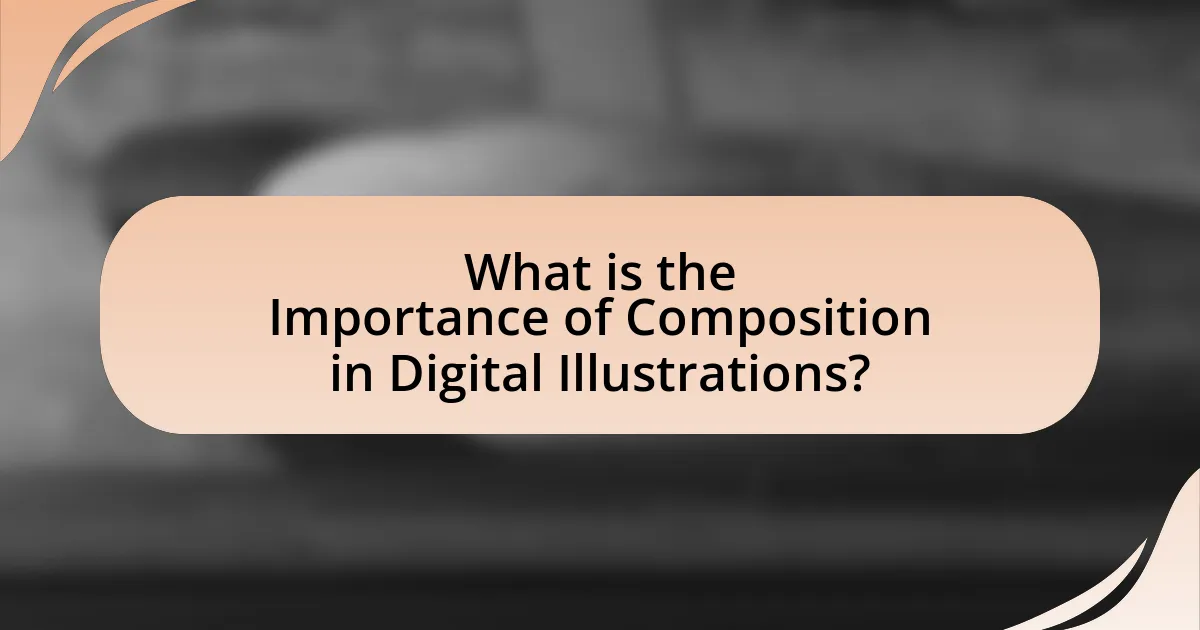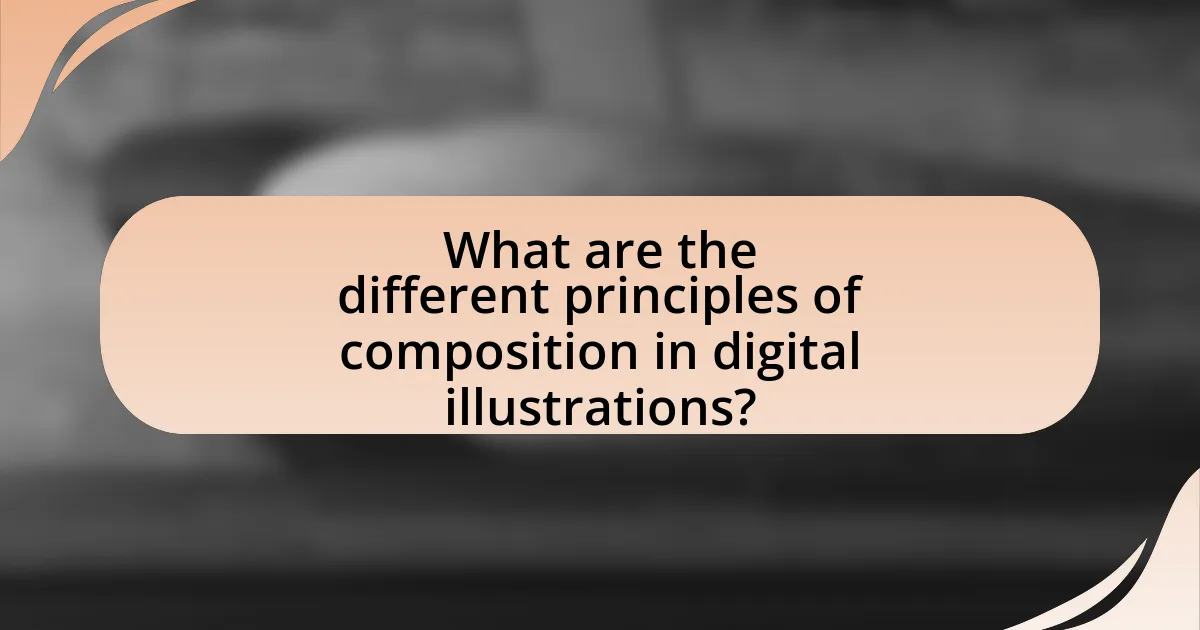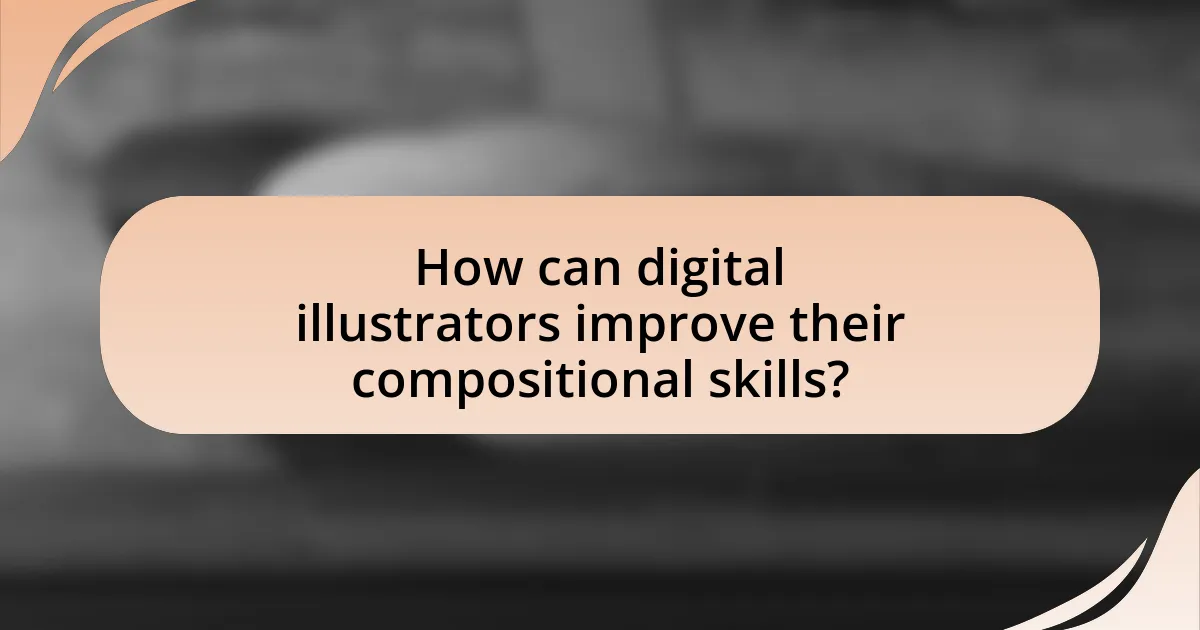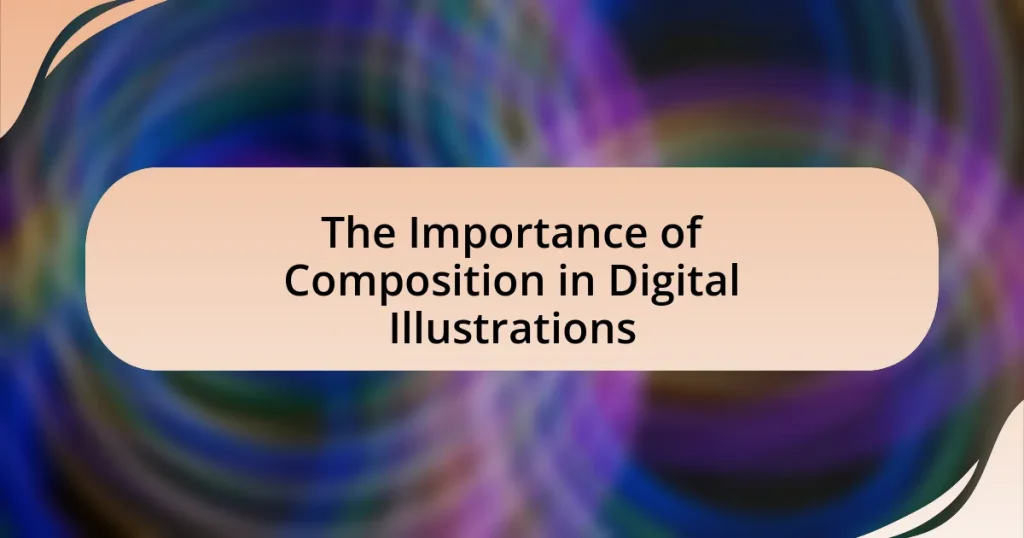The article focuses on the significance of composition in digital illustrations, emphasizing its role in arranging visual elements to create effective and engaging images. It outlines key compositional elements such as balance, contrast, focal points, and unity, which are essential for guiding viewer perception and enhancing emotional impact. The article also discusses the principles of composition, the influence of symmetry and asymmetry, and practical techniques for improving compositional skills. Additionally, it highlights common mistakes to avoid and resources available for learning about composition, underscoring the importance of community feedback in refining artistic abilities.

What is the Importance of Composition in Digital Illustrations?
Composition in digital illustrations is crucial as it determines how elements are arranged to create a visually appealing and effective image. A well-structured composition guides the viewer’s eye, establishes a focal point, and conveys the intended message or emotion. Research indicates that effective composition can enhance viewer engagement and comprehension, as seen in studies where images with strong compositional elements resulted in higher retention rates among audiences. Thus, mastering composition is essential for digital illustrators to communicate their ideas clearly and attractively.
How does composition influence the overall effectiveness of digital illustrations?
Composition significantly influences the overall effectiveness of digital illustrations by determining how visual elements are arranged to guide viewer perception and engagement. Effective composition utilizes principles such as balance, contrast, and focal points to create a harmonious and visually appealing image that captures attention. For instance, a well-composed illustration can lead the viewer’s eye to the main subject, enhancing understanding and emotional impact. Research indicates that illustrations with strong compositional techniques, such as the rule of thirds or leading lines, are more likely to evoke positive responses from viewers, thereby increasing their effectiveness in communication and storytelling.
What are the key elements of composition in digital illustrations?
The key elements of composition in digital illustrations include balance, contrast, focal points, hierarchy, and unity. Balance refers to the distribution of visual weight in an illustration, ensuring that no single element overwhelms the others. Contrast involves the use of differing colors, shapes, or sizes to draw attention and create visual interest. Focal points are specific areas that attract the viewer’s eye, guiding them through the artwork. Hierarchy establishes the importance of elements, often using size or placement to indicate which parts should be noticed first. Unity ensures that all components of the illustration work together cohesively, creating a harmonious overall effect. These elements are essential for effective visual storytelling and engagement in digital illustrations.
How does composition affect viewer perception and engagement?
Composition significantly influences viewer perception and engagement by guiding the viewer’s eye and establishing a visual hierarchy. Effective composition utilizes elements such as balance, contrast, and focal points to create a structured narrative that captures attention. Research indicates that well-composed images can increase viewer retention and emotional response; for instance, a study published in the Journal of Vision found that images with strong compositional elements are more likely to be remembered and elicit stronger emotional reactions compared to poorly composed images. This demonstrates that composition not only affects how viewers perceive an image but also enhances their overall engagement with the content.
Why is composition considered a fundamental skill for digital illustrators?
Composition is considered a fundamental skill for digital illustrators because it dictates how elements are arranged within a visual space, influencing the overall effectiveness of the artwork. Effective composition guides the viewer’s eye, creates balance, and establishes a focal point, which are essential for conveying the intended message or emotion. Research indicates that well-composed images are more engaging and memorable; for instance, studies in visual perception show that viewers are drawn to images with strong compositional structures, such as the rule of thirds or leading lines, which enhance visual storytelling.
What role does composition play in storytelling through illustrations?
Composition plays a crucial role in storytelling through illustrations by organizing visual elements to guide the viewer’s attention and convey narrative effectively. A well-structured composition can highlight key characters, actions, and emotions, thereby enhancing the overall message of the story. For instance, the use of the rule of thirds can create dynamic tension and focus, while leading lines can direct the viewer’s gaze toward important details. Research indicates that effective composition can increase viewer engagement and comprehension, as seen in studies that show how visual hierarchy influences interpretation in illustrated narratives.
How can poor composition detract from the intended message of an illustration?
Poor composition can significantly detract from the intended message of an illustration by causing confusion and misinterpretation. When elements within an illustration are poorly arranged, the viewer may struggle to identify the focal point, leading to a diluted or distorted understanding of the message. For instance, if key elements are overcrowded or lack visual hierarchy, the viewer’s attention may be diverted away from the main subject, resulting in a failure to convey the intended narrative or emotion. Research in visual communication indicates that effective composition enhances clarity and engagement, while poor composition can lead to cognitive overload, making it difficult for viewers to process information accurately.

What are the different principles of composition in digital illustrations?
The different principles of composition in digital illustrations include balance, contrast, emphasis, movement, pattern, rhythm, and unity. Balance refers to the distribution of visual weight in an illustration, ensuring that no single element overwhelms the others. Contrast involves the use of differing elements, such as color or size, to highlight important features. Emphasis directs the viewer’s attention to a focal point, often achieved through size or placement. Movement guides the viewer’s eye through the artwork, creating a sense of action or flow. Pattern involves the repetition of elements to create visual interest, while rhythm establishes a sense of organized movement through the arrangement of elements. Finally, unity ensures that all components of the illustration work together cohesively, creating a harmonious overall effect. These principles are foundational in creating effective and engaging digital illustrations.
How do balance and symmetry contribute to effective composition?
Balance and symmetry are essential elements that enhance effective composition by creating visual stability and harmony. Balance ensures that elements within a composition are distributed evenly, preventing any one area from overwhelming another, which can lead to a more engaging viewer experience. Symmetry, on the other hand, often evokes a sense of order and beauty, making compositions more aesthetically pleasing. Research in visual perception indicates that symmetrical designs are more likely to attract attention and be remembered, as demonstrated in studies by Palmer and Gardner (2004) in “The Role of Symmetry in Visual Perception.” Thus, both balance and symmetry contribute significantly to the effectiveness of digital illustrations by fostering viewer engagement and enhancing overall visual appeal.
What types of balance can be used in digital illustrations?
There are three main types of balance that can be used in digital illustrations: symmetrical balance, asymmetrical balance, and radial balance. Symmetrical balance involves arranging elements evenly on either side of a central axis, creating a sense of harmony and stability. Asymmetrical balance, on the other hand, achieves balance through the use of differing elements that have equal visual weight, allowing for more dynamic compositions. Radial balance arranges elements around a central point, leading the viewer’s eye outward in a circular pattern. These types of balance are essential in composition as they influence the visual impact and emotional response of the artwork.
How does symmetry versus asymmetry affect visual interest?
Symmetry enhances visual interest by creating a sense of balance and harmony, while asymmetry introduces dynamism and tension. Symmetrical compositions often evoke feelings of stability and order, making them visually appealing and easy to process. In contrast, asymmetrical designs can capture attention by creating movement and guiding the viewer’s eye through the artwork. Research in visual perception indicates that asymmetrical arrangements can lead to increased engagement, as they challenge the viewer’s expectations and encourage exploration of the composition. This interplay between symmetry and asymmetry is crucial in digital illustrations, as it influences how effectively the artwork communicates its message and retains viewer interest.
What is the significance of focal points in composition?
Focal points in composition are significant because they guide the viewer’s attention to the most important elements of an artwork. By strategically placing focal points, artists can create a hierarchy of information, ensuring that the viewer understands the intended message or narrative. Research indicates that compositions with clear focal points are more engaging and easier for viewers to interpret, as they provide visual anchors that enhance understanding and emotional impact. For instance, studies in visual perception demonstrate that the human eye naturally gravitates towards areas of contrast or detail, reinforcing the importance of focal points in directing attention effectively.
How can focal points guide the viewer’s eye through an illustration?
Focal points guide the viewer’s eye through an illustration by creating areas of interest that draw attention and establish a visual hierarchy. These focal points can be achieved through contrast, color, size, and placement, which help to direct the viewer’s gaze along a predetermined path. For instance, a bright color in a muted background can immediately attract attention, while larger elements can dominate the composition, leading the viewer’s eye from one point to another. Research in visual perception indicates that humans naturally gravitate towards areas of high contrast and significant detail, reinforcing the effectiveness of focal points in guiding attention.
What techniques can be used to create strong focal points?
To create strong focal points in digital illustrations, techniques such as contrast, color, and placement can be effectively utilized. Contrast draws attention by highlighting differences in light and dark areas, making the focal point stand out. Color can be used strategically; for instance, using a vibrant hue against a muted background can direct the viewer’s eye. Additionally, placement of elements according to the rule of thirds can enhance focus, as positioning key subjects at intersection points naturally attracts attention. These techniques are supported by principles of visual perception, which indicate that viewers are drawn to areas of high contrast and color saturation.

How can digital illustrators improve their compositional skills?
Digital illustrators can improve their compositional skills by studying the principles of design, such as balance, contrast, and focal points. Engaging with these principles allows illustrators to create more visually appealing and effective compositions. For instance, research indicates that understanding the rule of thirds can enhance the placement of elements within a piece, leading to a more dynamic visual experience. Additionally, practicing with various layouts and seeking feedback from peers can further refine an illustrator’s compositional abilities, as iterative learning is crucial in skill development.
What are some practical tips for enhancing composition in digital illustrations?
To enhance composition in digital illustrations, artists should utilize the rule of thirds, balance elements, and create focal points. The rule of thirds involves dividing the canvas into a grid of nine equal parts and placing key elements along these lines or at their intersections, which naturally draws the viewer’s eye. Balancing elements ensures that no single part of the illustration overwhelms others, creating a harmonious visual experience. Additionally, establishing focal points through contrast, color, or size directs attention to the most important aspects of the illustration. These techniques are supported by principles of visual perception, which indicate that well-composed images are more engaging and easier for viewers to interpret.
How can studying traditional art principles benefit digital illustrators?
Studying traditional art principles benefits digital illustrators by providing foundational skills in composition, color theory, and perspective. These principles, established over centuries, enhance an illustrator’s ability to create visually compelling and balanced artwork. For instance, understanding the rule of thirds can help digital artists effectively position elements within their compositions, leading to more engaging visuals. Additionally, knowledge of color harmony allows illustrators to select palettes that evoke specific emotions, improving the overall impact of their work. Research indicates that artists who apply traditional techniques often produce higher-quality digital illustrations, as they can draw upon a rich history of artistic practices to inform their modern creations.
What tools and software features can assist in achieving better composition?
Tools and software features that assist in achieving better composition include grid systems, layering capabilities, and color theory tools. Grid systems help artists align elements and create balanced layouts, while layering capabilities allow for the organization of different components, facilitating adjustments without affecting the entire composition. Color theory tools assist in selecting harmonious color palettes, enhancing visual appeal and coherence. These features are integral in digital illustration software like Adobe Photoshop and Illustrator, which provide robust functionalities that support effective composition techniques.
What common mistakes should digital illustrators avoid in composition?
Digital illustrators should avoid common mistakes such as neglecting the rule of thirds, failing to create a focal point, and using poor color contrast. Neglecting the rule of thirds can lead to unbalanced compositions, making the artwork less engaging; studies in visual perception indicate that images aligned with this rule are more aesthetically pleasing. Failing to create a focal point can confuse viewers, as they may not know where to direct their attention; effective compositions often guide the viewer’s eye to a specific area. Lastly, using poor color contrast can diminish the visibility of important elements, as research shows that high contrast improves readability and visual impact.
How can cluttered compositions negatively impact an illustration?
Cluttered compositions can negatively impact an illustration by overwhelming the viewer and obscuring the intended message. When an illustration contains too many elements, it can lead to confusion, making it difficult for the audience to focus on the main subject or theme. Research indicates that visual clutter can reduce comprehension and retention of information, as studies show that viewers are less likely to remember details from images that are overly complex. For instance, a study published in the journal “Cognitive Science” found that simpler visual designs enhance cognitive processing, allowing for better understanding and recall. Therefore, maintaining clarity through balanced composition is essential for effective visual communication in illustrations.
What are the signs of poor composition that illustrators should watch for?
Signs of poor composition that illustrators should watch for include lack of balance, unclear focal points, and ineffective use of space. A lack of balance can manifest as uneven distribution of visual weight, making the illustration feel unstable. Unclear focal points result in confusion about where the viewer’s attention should be directed, often caused by competing elements. Ineffective use of space can lead to overcrowding or excessive emptiness, detracting from the overall impact of the illustration. These issues can diminish the effectiveness of the artwork and hinder communication of the intended message.
What resources are available for learning about composition in digital illustrations?
Online courses, books, and tutorials are key resources for learning about composition in digital illustrations. Platforms like Skillshare and Udemy offer structured courses that cover the principles of composition, such as balance, contrast, and focal points. Additionally, books like “Drawing on the Right Side of the Brain” by Betty Edwards provide foundational knowledge on visual composition. Websites like YouTube host numerous tutorials from experienced illustrators that demonstrate practical techniques in real-time. These resources collectively enhance understanding and application of composition in digital illustrations.
Which books or online courses are recommended for mastering composition?
“Understanding Composition: 50 Principles of Good Design” by John McWade and “The Art of Composition: A Simple Application of Dynamic Symmetry” by Michel Jacobs are highly recommended books for mastering composition. Additionally, online courses such as “Fundamentals of Composition” on Skillshare and “Composition for Digital Artists” on Udemy provide structured learning paths. These resources are recognized for their practical approaches and have received positive reviews from learners, confirming their effectiveness in teaching composition skills essential for digital illustrations.
How can community feedback improve compositional skills in digital illustrations?
Community feedback can significantly enhance compositional skills in digital illustrations by providing diverse perspectives and constructive critiques. When artists share their work within a community, they receive insights that highlight strengths and weaknesses in their compositions, such as balance, focal points, and color harmony. Research indicates that peer feedback fosters skill development; for instance, a study published in the Journal of Visual Arts Practice found that artists who engaged in critique sessions improved their compositional techniques by 30% over a six-month period. This collaborative environment encourages artists to experiment and refine their styles, ultimately leading to more effective and engaging illustrations.


